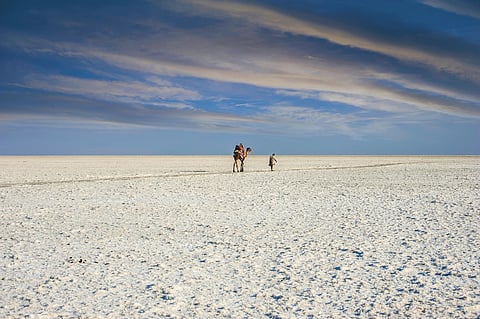
- Destinations
- Experiences
- Stay
- What's new
- Celebrating People
- Responsible Tourism
- CampaignsCampaigns
- Subscribe
- Buy Now

Gujarat's Rann of Kachchh, which is often celebrated for its moonlit terrain, handicrafts, and the much-loved Rann Utsav, recently added another, far older, chapter to its story. Thanks to a groundbreaking study by researchers from IIT Gandhinagar, in collaboration with IIT Kanpur, IUAC Delhi, and PRL Ahmedabad, the Great Rann has revealed secrets nearly 5,000 years old, before the rise of the Harappan civilisation.
Their findings, based on scientific dating of ancient shell remains first documented in 1872 by geologist Arthur Beavor Wynne, suggest that humans inhabited this region millennia before previously believed. These shell mounds or middens, remnants of early coastal communities, link the Rann to other prehistoric sites in Oman and Pakistan along the northern Arabian Sea, offering clues about the region’s connections with early trade routes, marine life, and human migration.
Today, when travellers arrive in the Rann—especially during the Rann Utsav that runs from October to February—they expect kaleidoscopic tents, folk dances, camel rides, and endless salt flats stretching into the distance. But scratch beneath the surface—quite literally—and the desert comes alive with stories of early man, ancient sea routes, and a changing landscape that transformed from a shallow sea into a marshy salt desert.
Once part of the Arabian Sea, the Rann of Kachchh’s dramatic transformation over millennia left behind a flat, arid expanse. However, its strategic coastal location ensured that it was host to communities long before establishing urban centres like Dholavira. The new research adds depth to this understanding, depicting a thriving pre-Harappan culture sustained by marine resources and possibly long-distance trade.
For history buffs and culturally curious travellers, this means the Rann of Kachchh is not just a spectacle but a silent museum. The villages scattered across the Banni Grasslands—Hodka, Dhordo, Nirona—are not only rich in crafts like Rogan art and ajrakh printing, but sit atop layers of untapped archaeological wealth. At sites like Dholavira, a UNESCO World Heritage site on Khadir Bet island, visitors can walk through a preserved Harappan city that adds context to this new research, anchoring the Rann as a vital prelude to one of the world’s oldest civilisations.
When to visit: Winter is the best time to visit—not just for the cooler temperatures and cultural festivals but also for birdwatching.
Getting There: Bhuj is the gateway to Rann of Kachchh, which is well-connected by rail and air. From here, one can travel by road to Dhordo, the hub of the Rann Utsav, or take detours to more offbeat corners like Kala Dungar (the Black Hill) or the flamingo-frequented wetlands of Chhari Dhand.
(With inputs from multiple reports)
